The Unifactor. A world born of the intellect, hallucinations and waking dreams of its author. An expanse which might just as well be called the Unimind, a pantheistic unshifting wonderland of the soul; instinctive in its creation and consistent in its mythology.
We first catch sight of one of its substrates in the stained glass window of a mansion or temple Frank has been assigned to clean.
These Jivas, the immortal essences found in all living beings, are sometimes espied in deaths forseen…
… and at other times encountered as watchful guardians.
The architect of this realm, Jim Wooding, revealed their origin through his delirious journals where they have been strange visitors from the very first.
In the episode above, the dancing shiva (Nataraja) and then the author form the Sanskrit character for the syllable, Aum, breaking the illusion of all earthly existence. He is stripped bare of outward trappings and spun into the recognizable shapes which drift through the Unifactor, their only identifying marks being the band of eyes which crown their “foreheads”.
In what may be a related episode, the pedlar that adopts Pupshaw and Pushpaw following Frank’s apparent death and entombment in Weathercraft…
…is seen in an earlier adventure selling Frank a selectively efficacious top…
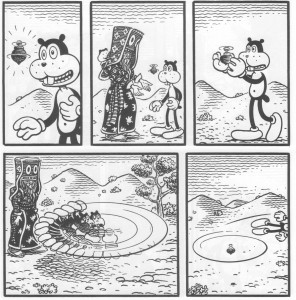

…a toy which is powerless against both Frank and Pupshaw who are childlike fools, but transformative when grasped by Manhog who becomes ensnared in a dry husk….
…which only a mother could love (and does).
As suggested by the author in a recent video presentation , the sorcerers or demi-gods which grace the cover of Weathercraft are also agents of change overseeing senescence, transitory growth, decay and ephemeral transformation.
The creatures prod the geriatric frog with their sticks, in this merely aping their predecessor in the form of Frank.
Their dress is suggestive of Indo-Aryan chic, their purpose impossible to divine.
The organizing element in the Unifactor are the lines scraped into the sky, ground and building walls which the artist dismisses (somewhat facetiously) as:
“…illegible sentences – revenge fantasies about my enemies, sex daydreams – that I write to relieve the drugery.”
They give the artwork the firmness and gravity of old prints. It is through these lines that the hags alter the shape of reality and animals…
…turning the Newtonian certainty of straight lines into a planned chaos which emanates like the waves of some strange ocean; a body of water not dissimilar or limited to that surrounding the island of Lanka (home of multi-headed Ravana), …
[Indian miniature showing a scene from the Ramayana]
…pervasive enough to cover even the walls of Whim’s (scientist and taskmaster of the Unifactor) cave, the folds of which Manhog disappears into in Woodring’s latest book.
These subterranean folds lead Manhog into the stomach of the fish which we first saw some pages earlier swallowing an inebriated Frank whole.
Perhaps a vision of Jonah, perhaps a distant memory of Vishnu as a fish rescuing the Vedas.
For the first time, this hapless figure, this half-man, half-animal is a picture of heroism and nobility, his metamorphosis achieved not through cosmic dances or tops but by cruelties inflicted on him by that creature of many masks and tricks, Whim.
Earlier in Weathercraft, an infernal creature plucked from the pig-man’s gullet sanctions enlightenment.
He who once resembled the demons surrounding the decapitated Ravana…
… becomes whole and fully clothed, now cognizant of his true nature.
Yet it should be noted, that this revelation of the inner workings of the universe…
…. achieved through richly deserved torture and anguish (for he is both a proven murderer and cannibal)…
[From an earlier adventure in the Frank series]
…was attained by pure chance many years earlier by his foolishly wise counterpart, Frank.
So much for the intellect.
The dedicated tourist can do no better than to stop by Amy Poodle’s abode in the realm of The Mindless Ones to understand the “preference for the aesthetic over the intellectual, the emotional over the cerebral, the imaginal over the physical” in most readers appreciation of Frank:
“Resonance, not cause and effect, is the prime-mover in Frank. The story tells itself the way it feels it should. We don’t necessarily understand all its contortions…but they make organic sense. This isn’t work to be empirically read, but to be watered. We watch it grow.”
This is a guide through the Unifactor which Woodring himself calls “the single best piece of writing” he has “ever seen on the lives and times of the thrice-lucky chuckbuster”. It is a fine example of the critical gloss and is an elaboration of Frank as filtered through half assimilated memories of anthromorphs and old cartoons (Disney and Fleischer; now filled with terrible sentient landscapes, architecture and fauna) – the “reassuring” and “cyclical” nature of these animations now displaced from their sense of indestructibility into a world of atrophy to become a meditation on existence and perception.
***
Other guides to the Unifactor and Weathercraft:
(1) A complete presentation of Weathercraft by Jim Woodring at Flog in which the bare bones of the plot are made crystal clear.
(2) Rod McKie, Ken Parille, Paul Rios, Tucker Stone on Weathercraft


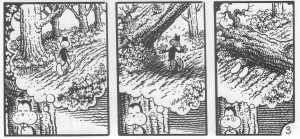
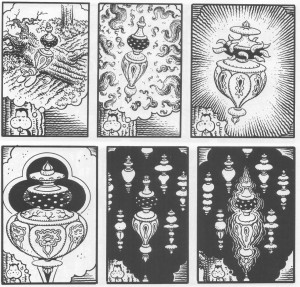


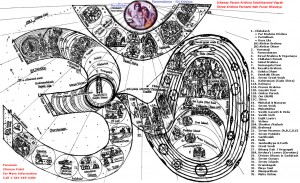
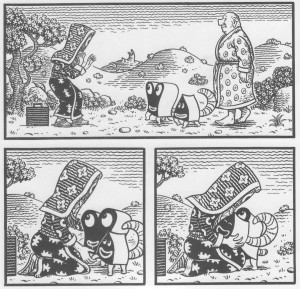
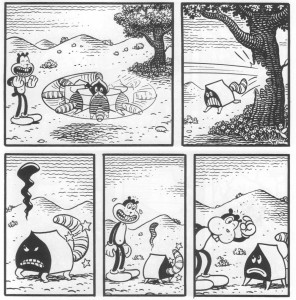
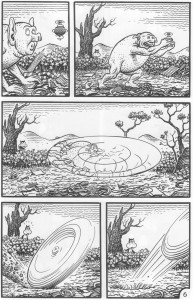
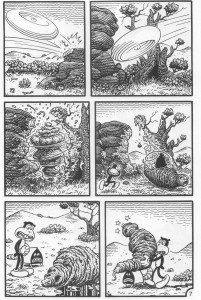
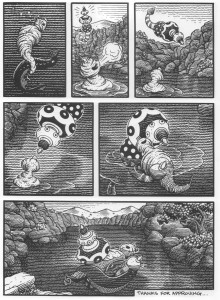
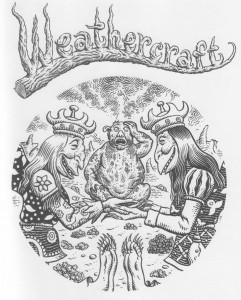
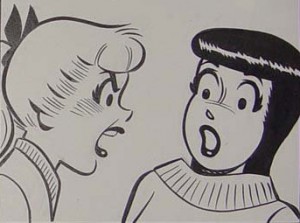
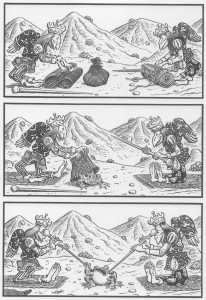

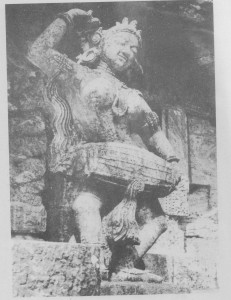

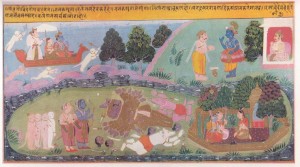
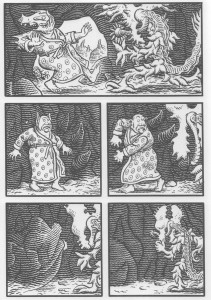


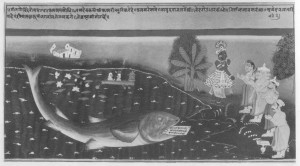

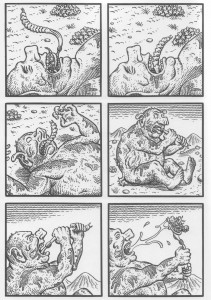
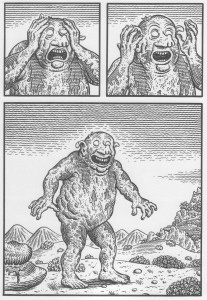
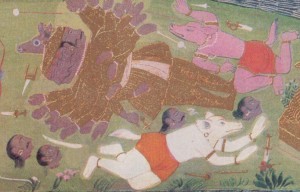

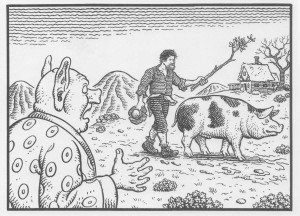
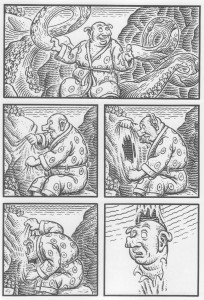
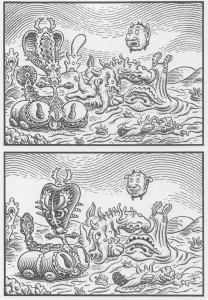

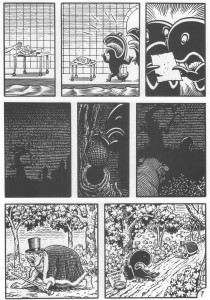
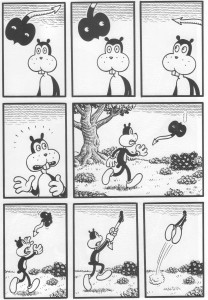
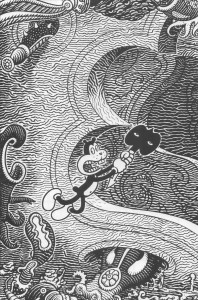
Okay, I’m baffled — the picture of Betty and Veronica…? What? Why?
Betty and Veronica are the names of the female creatures depicted in the image above the Archie characters.
Aha! Thanks!
Unless you’re kidding me? You’re not kidding me, are you?
I’m not kidding. I’m not well versed in Woodring’s work (though I’d love to rectify that), but I do have the FCBD preview of Weathercraft. That comic has bios of Woodring’s characters. The names stood out (for obvious reasons).
Nice interpretation Cole. Jim is perhaps the kindest cartoonist I have taken lessons from, as such I always see his work as very pliable by the reader. Free to deeply personal interpretations. Very post modernist. As I have argued on other threads, silent comics are superior because of intanicy and quality of craft needed for success. Even though I consider Frank to be pinical in cartooning, I am no expert on Woodring. I would state that he told us at SCAD, that man hog is his father. When reading this new work, I wondered if Jim had come to terms with his relationship with his father, because Manhog is cut a brake for a spell. But this thought is a distraction from a pure reading exseperionce where Jim guides you with skilled hands and mind, but he remains an ambiguous guide.
Yes, I would agree with you there. My impression is that Woodring is pretty accommodating when it comes to meaning as far as his comics are concerned. Which is as it should be and probably the reason why he has been more than willing to provide simple explanations of his comics to his audience at book readings.
For example, Paul Rios has this anecdote on the “wavy lines” at Ken Parille’s Blog Flume:
“Jim noted at his tour stop in Berkeley that the wavy lines are a sort of manifestation of the consciousness of the Unifactor. Or something like that.”
And on Rios’ own blog:
“When one fan asked a question about a part of the story and gave a personal interpretation, Woodring said that it seemed plausible and told her to email him the explanation so he could pass it on as part of the canon. He calls it reader participation, but maybe some of the elements of Woodring’s work are just a mint-leaf beyond explanation.”
There’s obviously a lot of personal symbolism at work in “Frank” which probably explains why most reviewers prefer to leave that aspect alone when addressing the series. Which is strange considering the author’s flexibility in such matters.
So we’re left with plain summaries and more impressionistic pieces of which Amy Poodle’s essay is by far the best example online – a mixture of personal experience and an analysis of influence.
Underscore personal. I think it is a mistake to not take advantage of an artists take on their own work, when they are both alive and forthcoming. I still enjoy the freedom for readers to interoperate. Jim is refreshing in his insight and his appreciation of others interpretations.
I have read and re-read Weathercraft and I still just don’t get it.
I mean I get that creating a mute novel required skill and attentiveness on the part of the artist, but his explanations for many symbols in his text are far so vague and surreal. They’re so out of this world its really difficult to grasp. I’m not even sure what to associate with certain creatures or rock or landscapes with eyes attached to them.
He’s well respected in the comic world and always celebrated for his craftsmanship – but I just don’t get it.
Every time I re-read it and read some of his vague responses I think – what was he on?
Pingback: Jim Woodring’s “Weathercraft” Named #6 Graphic Novel of 2010 | FergBlog
@Tootleloo: I think a lot of the magic of Woodring is that his work allows the reader to project their own psychological state onto his work. Very much like dreams borrow from random images and forms in our memory and project an unknowable alternate reality. Obviously Woodring may have his own mythology and symbolism packed into the panels, but he can’t honestly expect each reader to automatically tap into that back story. By keeping it wordless, I think it’s just begging for personal interpretation.
Pingback: Jim Woodring: ‘I am extremely interested in wrapping up Frank’ – Inb4Sales.com